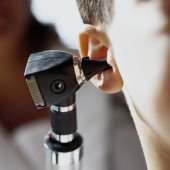Pediatrics group issues new ear infection guidelines

(HealthDay)—The American Academy of Pediatrics has issued new guidelines for identifying and treating a common childhood ailment that can cause a lot of misery—the ear infection.
In the guidelines released Monday, the pediatrics group more clearly defines the signs and symptoms that indicate an infection that might need treatment. They also encourage observation with close follow-up instead of antibiotic treatment for many children, including some under the age of 2 years. And, for parents of children with recurrent infections, the new guidelines advise physicians and parents when it's time to see a specialist.
"Between a more accurate diagnosis and the use of observation, we think we can greatly decrease the use of antibiotics," said the lead author of the new guidelines, Dr. Allan Lieberthal, a pediatrician at Kaiser Permanente Panorama City, in Los Angeles, and a clinical professor of pediatrics at the Keck School of Medicine at the University of Southern California.
The last set of guidelines was issued in 2004. Lieberthal said those stimulated a lot of new research, which provided additional evidence for the current American Academy of Pediatrics (AAP) guidelines appearing in the March issue of Pediatrics.
Lieberthal said the biggest change in the new document is the definition of the diagnosis itself.
Pediatrician Dr. Roya Samuels, who has reviewed the new guidelines, agreed. "The definition is more clear-cut, more precise," she said. But, she added, "There's still no gold standard for diagnosis. There are different stages of [ear infections], and making the diagnosis can be tricky."
Because the diagnosis isn't always easy to make, the AAP offers detailed treatment suggestions, encouraging observation with close follow-up, but also leaves it up to the discretion of the doctor whether or not to prescribe antibiotics. If children who are being observed don't improve within 48 to 72 hours from when symptoms first began, the guidelines recommend beginning antibiotic therapy.
Previous guidelines recommended giving antibiotics for ear infections in children age 2 and under. The new guidelines suggest that children aged between 6 months and 23 months can be observed with close follow-up as long as they don't have severe symptoms.
Another key component of the new guidelines is pain management. "Antibiotics take 24 to 48 hours before they start to improve signs and symptoms, so if a child has fever or pain, it's important to place them on [pain-relieving or fever-reducing medications]," Samuels said.
The guidelines also confirm that amoxicillin should be the antibiotic of choice unless the child is allergic to penicillin, or if the child has been treated with amoxicillin during the past month.
The new guidance from the AAP also states that children, even those with recurrent infections, shouldn't be on long-term daily antibiotics to try to prevent infections from occurring.
Children who have three or more ear infections in a six-month period, or four or more infections in a one-year period (with at least one infection occurring in the previous six months), should be referred to an ear, nose and throat specialist. That's because children with such frequent infections may need to have tubes placed in their ears for better fluid drainage.
Finally, the guidelines also recommend staying current on your child's vaccine schedule, particularly with the pneumococcal conjugate vaccine (PCV), and the annual flu shot.
"Studies show that anything that decreases viral infection will decrease the incidence of [ear infections]," Lieberthal said.
Both Lieberthal and Samuels said that parents increasingly understand the importance of trying to reduce the use of antibiotics. First, because it exposes their child to unnecessary risks from side effects if they didn't need an antibiotic. And, second, because parents understand the dangers of developing antibiotic resistance.
"Parents are getting more comfortable with the idea of watching and waiting, as long as they know they can come back for antibiotics if their child's symptoms don't improve," Samuels said.
More information: Learn more about ear infections from the U.S. National Library of Medicine.
Health News
Copyright © 2013















